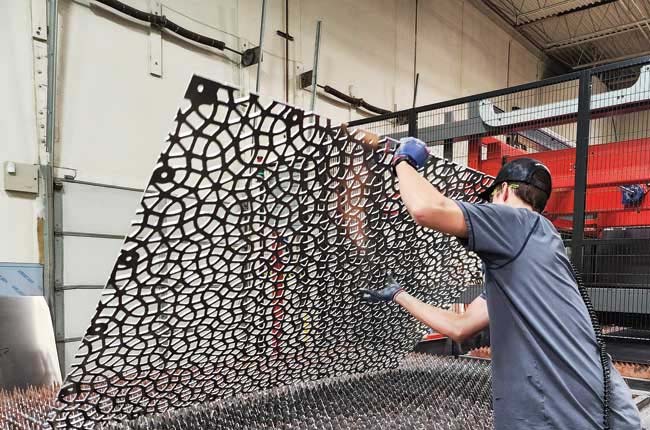How Sheet Metal Fabrication Contributes to the Advancement of Technology

Sheet metal fabrication is a fascinating process that transforms thin sheets of metal into functional and intricate parts and structures. This process is essential in many industries and has significantly contributed to the advancement of technology. Let’s explore how sheet metal fabrication is driving technological progress in various fields.
What is Sheet Metal Fabrication?
Sheet metal fabrication involves cutting, bending, and assembling thin metal sheets into different shapes and products. The metals commonly used include steel, aluminum, copper, and brass. This fabrication process uses tools like lasers, presses, and welding machines to create everything from small electronic components to large machinery parts.
Precision and Customization

One of the keyways sheet metal fabrication advances technologies is through its precision and customization capabilities. Modern fabrication techniques, like computer numerical control (CNC) machining, allow for extremely precise cuts and bends. This precision is crucial in industries such as aerospace and electronics, where even the smallest error can lead to significant problems.
For example, in the electronics industry, sheet metal is used to create enclosures and housings for sensitive components. These enclosures must be precisely manufactured to protect the components from external factors like dust and moisture while allowing for proper ventilation.
The high level of precision offered by sheet metal fabrication ensures these components fit perfectly and function reliably.
Innovation in Material Use
Advancements in sheet metal fabrication have also led to the development and use of new materials. Lightweight metals like aluminum and titanium are now commonly used in various industries. These materials are not only strong but also lightweight, making them ideal for applications where weight is a critical factor.
In the automotive industry, for instance, the use of aluminum in car bodies has become more prevalent. Aluminum's lightweight nature helps improve fuel efficiency and reduces emissions, contributing to more environmentally friendly vehicles.
Similarly, in the aerospace industry, titanium is used for aircraft parts due to its strength and resistance to corrosion, ensuring safety and longevity.
Enhancing Product Durability and Longevity

Sheet metal fabrication contributes to the durability and longevity of products. The fabrication process often includes treatments like galvanization or powder coating, which protect the metal from rust and corrosion. These treatments are essential for products exposed to harsh environments, such as outdoor equipment and machinery.
By enhancing the durability of products, sheet metal fabrication helps reduce the need for frequent replacements, saving both time and resources. This aspect is particularly important in industries like construction and agriculture, where equipment and structures must withstand tough conditions.
Supporting Technological Innovations
Many technological innovations rely on sheet metal fabrication for their development and production. For example, the renewable energy sector depends on sheet metal fabrication for components like solar panel frames, wind turbine parts, and battery enclosures. These components must be robust and precisely manufactured to ensure optimal performance and efficiency.
Additionally, the medical industry benefits from sheet metal fabrication. Medical devices and equipment, such as MRI machines and surgical instruments, often contain sheet metal parts. The ability to produce these parts with high precision and in sterile conditions is vital for the safety and effectiveness of medical treatments.
Supporting Technological Innovations
Many technological innovations rely on sheet metal fabrication for their development and production. For example, the renewable energy sector depends on sheet metal fabrication for components like solar panel frames, wind turbine parts, and battery enclosures. These components must be robust and precisely manufactured to ensure optimal performance and efficiency.
Additionally, the medical industry benefits from sheet metal fabrication. Medical devices and equipment, such as MRI machines and surgical instruments, often contain sheet metal parts. The ability to produce these parts with high precision and in sterile conditions is vital for the safety and effectiveness of medical treatments.
Rapid Prototyping and Production

The ability to quickly prototype and produce parts is another significant contribution of sheet metal fabrication to technological advancement. Rapid prototyping allows engineers and designers to create and test new ideas quickly. This process speeds up the development cycle of new products, enabling faster innovation.
For instance, in the consumer electronics industry, companies need to bring new products to market swiftly to stay competitive. Sheet metal fabrication allows them to create prototypes of new devices, test them, and make necessary adjustments before mass production. This rapid turnaround helps drive technological progress and keeps the market filled with the latest gadgets and innovations.
Conclusion
Sheet metal fabrication is a cornerstone of modern technology, playing a crucial role in the advancement of various industries. Its ability to provide precision, support new material use, enhance product durability, and facilitate rapid prototyping makes it indispensable.
As technology continues to evolve, sheet metal fabrication will remain a vital component, driving innovation and helping to create the advanced products and systems that shape our world.